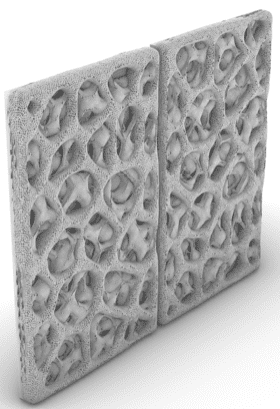This story is part 1 of an Opportunity Miami x Refresh Miami Startup Series on entrepreneurs addressing issues pivotal to Miami’s economic future.
By Riley Kaminer
$200 billion over the next 20 years: That’s the bill facing Miami-Dade residents to deal with climate change-induced rising sea levels, according to the U.S. Army Corps of Engineers.
This is just one of the many reasons that Miami is on the front lines of climate change. The good news is that Miami also aims to be on the cutting edge of ‘climate tech,’ a term encompassing new business models or technologies that work to combat the effects of climate change.
Kind Designs is one of these firms. It has developed a process for 3D printing seawalls more cheaply, quickly, and flexibly than traditional methods, through its Living Seawalls product.
Co-founder Anya Freeman is on a mission to make cities resilient to climate change. The Ukraine native grew up in Israel and the U.S. before landing in Miami for law school. She’s remained in Miami ever since.
After grad school, Freeman built her first business: a law firm. “But I felt like it was just not impactful enough,” Freeman explained. “My passion really is technology, and I wanted to find the marriage of purpose and scale.”
She turned to futurist Peter Diamandis’ program, Abundance360, to help her find purpose. The group brings global innovators and technologists together, promoting conversations about how to solve some of the world’s most pressing issues. It was there that Freeman learned about the power of large-scale 3D printing technology, and how to harness it to mitigate the effects of climate change.
This investigation led Freeman to the issue of rising sea levels. “I was just amazed at how expensive sea walls were and how big the market was, and the fact that Miami is by far the number one city when it comes to sea wall production globally.”
Building Living Seawalls
There are a handful of advantages to 3D printing seawalls. Top of the list is that they are much faster to construct. That speed is critical: Kind Designs estimates that Florida alone will need 10,000 miles of sea walls or 20 million of the company’s Living Seawall panels to help combat rising sea levels by 2040.

While traditional seawalls typically degrade after 30 to 40 years, Kind Designs expects its product to last much longer. That’s because the startup is using a proprietary additive to strengthen the seawalls using recycled marine plastic fibers rather than rebar. Cost is also an important factor. Kind Designs’ Living Seawalls are significantly less expensive because they can 3D print 95% of the project.
The “living” aspect of their seawalls is particularly advantageous. The design mimics coral reefs and mangroves, which promote biodiversity and improve the water quality. Additionally, the seawalls will have embedded sensors to monitor data such as pH levels and water temperature in real-time.
Kind Designs is currently in the process of raising a $5 million seed financing round.
Miami as a hub for climate tech innovation
Miami is at the center of Kind Designs’ efforts. The startup is developing two pilot projects here, plus one on Richard Branson’s Necker Island in the British Virgin Islands. Kind Designs is also in talks with Key Biscayne to see how their Living Seawalls can help protect one of the towns in Miami-Dade that is most vulnerable to rising sea levels. Production has already begun, and we will see panels in the water as early as this summer.
“The biggest hurdle for us is government regulation, particularly in permitting and building codes,” said Freeman. “It’s very difficult to move at the speed that’s necessary when it comes to addressing climate challenges.”
In Miami, Kind Designs has found public servants who are very willing to help bring their projects to life. That said, the team has experienced what co-founder James Layfield described as a “big disconnection between all the entities” within various city governments.
“There are so many bureaucratic steps that we have to take,” explained Layfield, a serial entrepreneur focused on creating positive change through innovation. “That makes it more difficult. It’s not as efficient a process as startups need.” Breaking down these silos, in his estimation, would help unlock innovation in the climate tech space.
Layfield also believes that there is a need for infrastructure to bring venture capitalists and startups together more frequently. “Some sort of matchmaking facility would be useful,” he said. These connections already happen serendipitously, but he believes that it would be better to have a structure in place for more proactive partnerships between different key players in the climate tech ecosystem.
Collective action is key for climate change innovation
More broadly speaking, Layfield advocates for more collaboration. Collective action is particularly important in combating rising tides because residents having or not having sea walls can affect their neighbors. “Shouldn’t we talk as a county about putting in place some sensible legislation that says, if one person puts up a seawall then the next person probably should too?”
Layfield also underscored the role of the private sector. For instance, he believes that mortgage lenders should be a part of the conversation to ensure that they’ve secured their loans against these climate risks.
He also highlighted the major economic opportunity these seawalls will bring, particularly in the construction field. Freeman also mentioned that Kind Designs hopes to collaborate with a local university to retrain some construction workers to become 3D printer operators.
“It’s a very exciting time to innovate,” said Freeman. “I strongly believe that Miami will become an example for the rest of the world, based on how we can address the challenges of climate change in a way that is fantastic for the environment and fantastic for the local economy.”

This story is part 1 of an Opportunity Miami x Refresh Miami Startup Series on entrepreneurs addressing issues pivotal to Miami’s economic future. The story is also published by Opportunity Miami on its Medium channel. Stay tuned for future installments this month.





